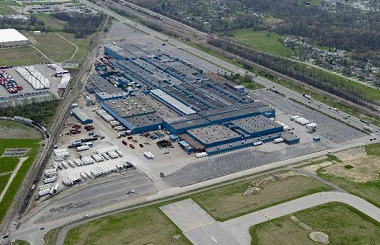
October 2014
In This Issue
EDA in the NewsSuccess Story: NEXCAP - Manufacturing’s Matchmakers Screenshot of NEXCAP website
If you build it, they will come. But what if it’s built and no one knows it? In the United States, there are hundreds of millions of square feet of nonproductive commercial, industrial, and manufacturing space. This space provides an opportunity for domestic companies to find manufacturing spaces as well as foreign companies looking to locate operations in the United States. However, information about this space can be incomplete and scattered. That’s where NEXCAP comes in. With funding from EDA, the National Excess Manufacturing Capacity Catalog (NEXCAP) is uniquely and comprehensively cataloging these vacant manufacturing facilities, their assets, and those of the surrounding community. The searchable catalog offers companies seeking manufacturing production sites/facilities in the U.S. a complete and detailed overview of potential manufacturing sites. NEXCAP's site inventory and portal is populated with detailed profiles of the facilities and their host communities. It provides companies seeking locations with a toolkit of information to guide their business location and/or expansion decisions. This benefits the communities with properties by attracting investment and new, job creating industries. The NEXCAP portal is designed for users to create an account, save their searches, and be notified when new property listings are available. NEXCAP’s catalogue also includes an input process and tool that will match facilities with companies looking for space. So far, NEXCAP has developed a comprehensive inventory database of closed plants and sites in the eastern half of the United States, based on a consistent method and template. As the second year of the program begins, NEXCAP will expand its inventory to include closed plants and sites in the western part of the country, covering the entire United States. To-date, there have been more than 3,000 visits to the website from more than 1,000 unique users in 70 countries across the globe. Countries with the most visitors included the United States, Brazil, Chile, India, France, Netherlands, Switzerland, Germany, Mexico and Argentina. Several companies have already found new homes in these previously empty facilities. Since February, 2013, WCR, Inc., which manufactures heat exchanges in locations across the globe, has set up shop in 60,000 sq. ft. of the former GM Assembly Plant in Moraine, Ohio. In Lorain, Ohio, a former 300,000 sq. ft. Ford assembly plant has been transformed into the home of Trademark Global, a mass market internet retailer.  Park 41, a NEXCAP property and former Whirlpool Plant, in Evansville, IN
"NEXCAP is a tool and a resource to attract foreign direct investment into the manufacturing sector to create jobs and to bring back to productive use closed manufacturing facilities nationwide, said Lawrence Molnar, Associate Director University of Michigan Institute for Research on Labor, Employment, and the Economy. “Given the volume and breadth of the traffic from around the world it is obviously an effective resource." An empty building can’t create jobs or grow a community’s economy. But, letting businesses at home and abroad know that there is existing space to meet their needs has transformative potential. If it’s already been built, and you tell them it’s available, they will come, bringing jobs and new opportunities with them. Guest Column: Next-shoring: A CEO’s guide Katy George, Director, McKinsey
The importance of manufacturing to the American economy is undeniable. Economic development is crucial to supporting manufacturing communities (and vice versa), and the work many of you do to build infrastructure or develop the local workforce is contributing to the growth of manufacturing across the country. But manufacturing is changing, and its future looks nothing like its history. Rather than focus on offshoring or even “reshoring”—a term used to describe the return of manufacturing to developed markets as wages rise in emerging ones—today’s manufacturing strategies need to concentrate on what’s coming next. The synopsis below is adapted from “Next-shoring: A CEO’s guide,” an essay I wrote with Sree Ramaswamy and Lou Raseey for the McKinsey Quarterly, January 2014. Please visit for a full collection of content on the future of manufacturing. – Katy George Katy George is a director in McKinsey’s New Jersey office; Sree Ramaswamy is a fellow of the McKinsey Global Institute and is based in the Washington, DC, office; and Lou Rassey is a principal in the Chicago office. Evolving demand from new markets places a premium on the ability to adapt products to different regions. Meanwhile, emerging technologies that could disrupt costs and processes are making new supply ecosystems a differentiator. Accordingly, a next-shoring perspective emphasizes two forms of proximity: to demand and to innovation. Economic fundamentalsThe case for next-shoring starts with the economic fundamentals of demand (since the importance of local factors is growing) and supply (as the dynamics of labor and energy costs evolve). Most demand is local. More than two-thirds of global manufacturing activity takes place in industries that tend to locate close to where their products are sold. This simple fact helps explain why manufacturing output and employment have recently risen, both in mature economies and in emerging markets such as China. Emerging markets’ share of global demand is also climbing, from roughly 40 percent in 2008 to an expected 66 percent by 2025. As that share rises, the diversity of needs it reflects leads to fragmentation: in the automobile industry, 90 percent of recent capital expenditures have involved product derivatives worldwide and capacity expansions in new markets. Labor costs become less important... Rapid wage growth in China hasn’t choked off manufacturing expansion there. True, in a few labor-intensive, trade-oriented industries such as apparel, labor-cost changes often tip the balance in locating production. But higher wages in China are also increasing local demand, thus reinforcing manufacturers’ local-investment choices. …and energy costs, too? In part because of lower natural-gas prices, the McKinsey Global Institute (MGI) estimates that by 2020, lower-cost energy could boost US GDP by $400 billion to $700 billion. And energy-storage technologies, especially lithium-ion batteries and fuel cells, are becoming more capable and less costly. As advances continue, more companies may be able to focus on local demand patterns rather than energy concerns in placing their geographic bets. Technology disruption aheadAt the same time, advanced robotics, 3-D printers, and the large-scale digitization of operations are poised to alter fundamental assumptions about manufacturing costs and footprints. Advanced robotics. Cheaper, more proficient robots are another reason companies may locate more manufacturing closer to major demand markets—both in developed countries and in developing nations, where robots could bridge shortages of some production skills. MGI research suggests that 15 to 25 percent of the tasks of industrial workers in developed countries and 5 to 15 percent of those in developing countries could be automated by 2025. 3-D printing. Cheaper 3-D printing is already allowing some companies to accelerate product development. Soon, targeted usage of in-house printers will enable new supply-chain models that, in some cases, may replace traditional parts suppliers. The equivalent of copy or print shops may emerge to manufacture items based on customers’ design specifications. Digitized operations. Cloud computing, mobile communications, advanced analytics, and the Internet of Things—the growing collection of sensors and actuators embedded in products and equipment—are starting to combine in powerful ways. Increasingly, products can communicate: with each other, with robots and advanced machines inside factories, and with customers and suppliers. Manufacturers will get an unprecedented global view into who makes what, where, and how well, enabling some to buy and sell underused production lines “by the hour.” Next-shoringIn developing and emerging markets alike, both proximity to demand and proximity to innovation will be critical. Next-shoring isn’t about the shift of manufacturing from one place to another but about adapting to, and preparing for, the changing nature of manufacturing everywhere. Optimizing location decisions. New products, market segments, and consumer preferences are exacerbating perennial risks (such as variations in seasonal demand, wages, and exchange rates) to boost uncertainty. Operational agility—the ability to adapt design, production, and supply chains rapidly to fluctuating conditions while preserving economies of scale—will thus carry an even greater premium. Volkswagen, for example, has moved from traditional vehicle platforms to modular architectures that provide greater flexibility for manufacturing several product variants. Building supplier ecosystems. New combinations of technical expertise and local domain knowledge will become the basis for powerful new product strategies relying on collaborative supplier ecosystems. More-robust information flows among partners will yield improvements ranging from surer logistics to better payment systems. Many manufacturers’ supply bases may thus need significant upgrades to create joint competencies in areas such as robotics. Developing people and skills. All this will place a premium on manufacturing talent. Organizations will need to invest more in formal training and on-the-job coaching to bridge crucial gaps, such as too few technically skilled workers in advanced economies and too many workers experienced only in routine manufacturing in developing economies. The ability to build external relationships—with suppliers, education partners, and local-government officials who can influence the development of vibrant, sophisticated supply ecosystems—will be a major source of competitive advantage. □ □ □ The new question for manufacturers won’t be whether to produce in one market for another, but how to tailor product strategies and match local needs with the latest manufacturing know-how and digital expertise. Accordingly, while the road map for every company, industry, and location will be different, we believe that the principles we’ve laid out here should be useful for all. Copyright © 2014 McKinsey & Company. All rights reserved. Highlight: EDA’s FY2014 Manufacturing Footprint DAS Erskine and representatives from the Devens, Massachusetts Community at a grant announcement to improve road access for local manufacturing
Manufacturing built many parts of this country. It created hundreds of jobs and enabled the birth of the middle class. But over the years, some manufacturing communities have seen decline due to outsourcing or changes in the market. Yet, through the fluctuations and changes, the sense of pride in American manufacturing hasn’t diminished. Today, manufacturing is experiencing a renaissance in the United States. Companies are bringing operations back to the U.S., entrepreneurs are bringing new products to market, and the industry is evolving to and adapting to new technologies. Manufacturing is creating jobs – jobs that are high-paying. But, it’s also helping the economy. For every $1.00 spent in manufacturing, the sector generates $1.32 for the U.S. economy. EDA understands the crucial importance of manufacturing to the economic recovery and to future economic growth. In FY2014, EDA invested in 89 manufacturing projects, totaling nearly $78 million. The projects were diverse, representing different industries, different geographies, and different community needs – much like manufacturing itself. EDA supported these projects in a number of different ways. Half of the manufacturing projects EDA supported in the last fiscal year were construction projects, which are expected to create more than 7,000 jobs and generate nearly $4.3 billion in private investment. In Devens, Massachusetts, we funded critical road improvements that providing easier access to the business park, enabling the projected creation of 460 jobs for the community. And in Lancaster, South Carolina, a $900,000 grant to construct core infrastructure meant that an international textile manufacturing company was able to locate there that will create 150 jobs for the community. Even relatively small investments managed to have big impacts. In Yadkin Valley, North Carolina, a $355,000 grant to upgrade the sewer system that served the industrial park is estimated to create 260 jobs and generate $83 million in private investment. EDA grants also helped launch a number of planning efforts intended to boost manufacturing. Also in FY2014, EDA continued supporting the Investing in Manufacturing Communities Partnership (IMCP) initiative. After announcing $7 million in planning grants in FY2013, EDA and its federal partners designated 12 Manufacturing Communities through a competitive process with nearly 80 very qualified applicants. In May, the 12 IMCP designated communities were announced and work is already getting underway in each of the communities. Since the end of the recession, the manufacturing sector has created more than 700,000 quality jobs, and the industry currently supports 17.4 million U.S. jobs. The new fiscal year brings new projects and new opportunities to continue EDA’s strong support of manufacturing. |
|
|
|||
Assistant Secretary Williams Spends Manufacturing Day in WichitaOctober 3rd marked Manufacturing Day, where more than 1,500 manufacturers opened their doors for public tours, open houses, and other events in order to educate people about modern manufacturing. Assistant Secretary Jay Williams visited Wichita, Kansas, where he announced an EDA grant for $1.9 million to Wichita State University. EDA’s investment will be used to purchase equipment for a multi-robotic additive manufacturing laboratory. The new equipment will enable manufacturers, entrepreneurs and designers to use virtual reality to test automated processes and verify that they are sustainable, scalable, affordable, and maintainable before investing in implementation. According to the grantee, the investment will create 500 jobs. Assistant Secretary Williams also had the opportunity to tour the Bombardier-Learjet facility in Wichita as part of the manufacturing day festivities. Applications are being accepted for the Manufacturing CouncilThe Office of Advisory Committees and Industry Outreach is now accepting applications for the next term of the Manufacturing Council. The Manufacturing Council was established in 2004 to enhance the U.S. Government’s focus on increasing U.S. manufacturing competiveness. The Council consists of up to 30 private sector individuals who advise the Secretary of Commerce on policies and programs that affect manufacturing, provide a forum to discuss and propose solutions to industry related problems, and ensure that the US remains the top world destination for manufacturing in the world. Members serve a two-year term and are expected to attend all quarterly meetings and cover their own travel and personal costs. For application details please see the announcement in the Federal Register. Applications are due by October 14, 2014. EDA and Partners to Host IMCP SummitOn October 30th and 31st, EDA and our federal partners are hosting a Summit on the Investing in Manufacturing Communities Partnership program. The conference will include sessions on best practices, evaluation and metrics, building effective partnerships, and more. There will also be ample time for networking and network building. Registration is open through October 20th. For more information, please contact Tami Holzman. President Obama Announces New Manufacturing Innovation Institute CompetitionOn October 3rd in honor of Manufacturing Day, the President announced a new competition to award more than $200 million in public and private investment to create an Integrated Photonics Manufacturing Institute, led by the Department of Defense, and the second of four new institute competitions to be launched this year. In order to continue strengthening American manufacturing, the President has called for investments that directly support innovations in manufacturing, like investments in research and development, but also investments in education and worker training that will continue to ensure America’s manufacturing sector is fueled by the best-trained, most highly skilled workforce in the world. To further these goals, he is announcing new resources and tools to spur growth in the American manufacturing sector, create jobs, and support opportunities for the middle class. For more information, check out the White House Fact Sheet about Administration manufacturing efforts. |
